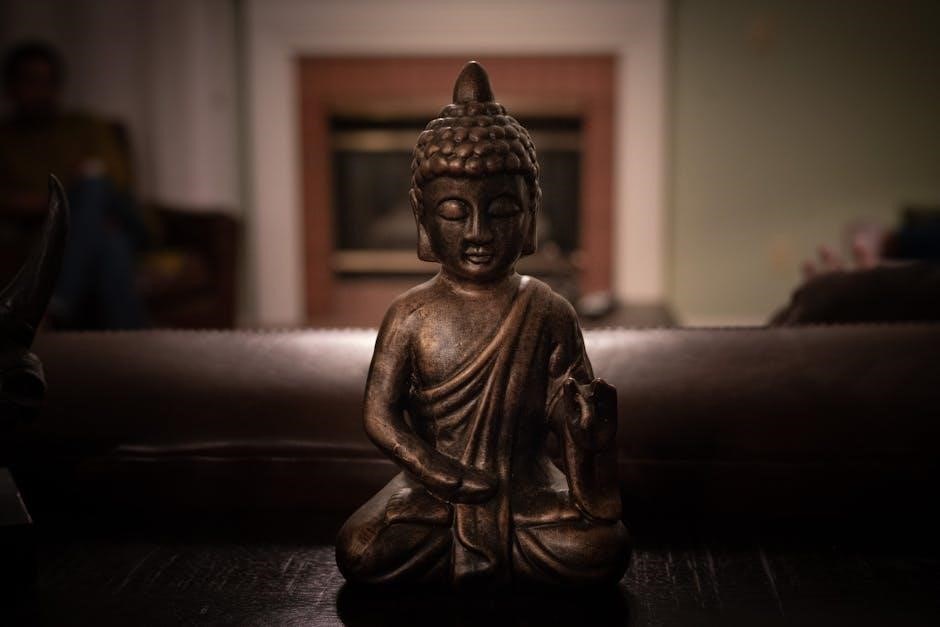Zen in the Art of Archery: An Overview
Eugen Herrigel’s work illuminates the mind-body connection through his archery experience with Zen masters. It chronicles his six-year journey overcoming self-limitations, bridging Eastern practice and Western thought. The book discusses Zen principles within archery, sharing insights from his studies in Japan.

Eugen Herrigel and His Journey
In the 1920s, Eugen Herrigel journeyed to Japan seeking Zen. He embarked on a six-year apprenticeship in archery, documented in his renowned book. This transformative period shaped his understanding, bridging cultural gaps and exploring the essence of Zen practice.
Herrigel’s Motivation for Studying Zen Archery
Eugen Herrigel’s motivation stemmed from a deep desire to understand Zen experientially, not just intellectually. As a German academic, he sought a direct encounter with Japanese culture and philosophy. He was not satisfied with the Western interpretations of Zen, yearning for authentic understanding. Herrigel believed that archery, as a traditional Japanese art form deeply intertwined with Zen principles, offered a unique pathway to this understanding. He aimed to bypass the limitations of Western thought and access a more intuitive and embodied knowledge. He desired to immerse himself fully, hoping the discipline would unlock the secrets of Zen, leading to personal transformation and a deeper appreciation for Eastern wisdom. His pursuit was driven by a quest for genuine insight, beyond the grasp of mere academic study, and a yearning to bridge the gap between intellectual understanding and lived experience. This propelled his six-year journey.
The Six-Year Apprenticeship
Herrigel’s six-year apprenticeship in Zen archery was a rigorous and transformative journey. Under the tutelage of a master, he faced immense challenges, struggling to reconcile Western thought processes with the intuitive nature of Zen. The training emphasized precise form and technique, but also demanded a complete surrender of the ego. Herrigel grappled with frustration, constantly striving for perfection, yet the master insisted on detaching from the outcome. He had to unlearn ingrained habits, embracing “mushin” or “no-mind.” The process involved repetitive practice, demanding patience and perseverance. He learned to breathe correctly, align his posture, and release the arrow without conscious intent. Through relentless dedication, Herrigel gradually shed his intellectual preconceptions. He began to experience moments of profound clarity, glimpsing the essence of Zen. The apprenticeship fostered a deep connection between mind, body, and spirit. It ultimately reshaped his understanding of self and the universe.
Key Principles of Zen Archery
Zen archery intertwines mental discipline with physical technique, emphasizing principles like “mushin” (no-mind), proper breathing, and posture. The goal transcends mere target hitting, aiming for self-discovery and enlightenment through mindful action.
Mushin (No-Mind)
Mushin, often translated as “no-mind,” is a critical principle within Zen archery, representing a state of mental clarity and freedom from conscious thought. It is achieving a mind empty of distractions, expectations, and judgments, enabling instinctive action. In this state, the archer transcends the ego’s interference, allowing the shot to flow naturally without hesitation or analysis.
The archer cultivates Mushin through rigorous practice and meditation, gradually diminishing the gap between intention and execution. It’s not about suppressing thoughts but rather observing them without attachment, letting them pass like clouds in the sky. This mental discipline allows for a pure, unadulterated response to the present moment, fostering a deeper connection with the art of archery and oneself.
Ultimately, Mushin embodies the essence of Zen philosophy, promoting spontaneity, intuition, and the uninhibited expression of one’s true nature through the practice of archery.
The Importance of Breathing and Posture
In Zen archery, breathing and posture are not merely physical techniques but fundamental elements that cultivate the mind-body connection, essential for achieving Mushin. Correct posture provides a stable and balanced foundation, allowing the archer to align their physical and mental energy. It promotes a sense of groundedness and centeredness, facilitating a natural flow of movement throughout the body.
Breathing, specifically diaphragmatic breathing, is used to calm the mind, regulate energy flow, and synchronize the archer’s actions. Deep, controlled breaths help to release tension, focus concentration, and create a rhythm that harmonizes with the drawing of the bow and the release of the arrow.
Through conscious attention to breathing and posture, the archer develops a heightened awareness of their body and mind, creating a unified state that transcends mere physical skill. This mindful integration is key to unlocking the deeper spiritual dimensions of Zen archery.

The Myth of Zen in the Art of Archery
Yamada Shoji critiques Herrigel’s work, highlighting its mythical nature. Language barriers and misinterpretations contributed to this myth. It’s crucial to reconsider Herrigel’s text and related materials to understand the cultural exchange complexities.
Yamada Shoji’s Critique
Yamada Shoji’s critique challenges the widespread interpretation of Eugen Herrigel’s “Zen in the Art of Archery” as a definitive study of Japanese culture. Shoji’s analysis delves into the mythical elements present within Herrigel’s narrative, suggesting a gap between the author’s experience and the reality of Zen archery.
He argues that Herrigel’s Western perspective and potential misinterpretations contributed to a romanticized and perhaps inaccurate portrayal of the practice. Shoji’s work encourages a re-evaluation of Herrigel’s text. It promotes critical engagement with the cultural nuances and complexities often overlooked.
By reconsidering the text and related materials, Shoji aims to clarify the mythical nature of “Zen in the Art of Archery;” Ultimately, he hopes to foster a deeper understanding of Zen and Japanese culture.
Language Barriers and Misinterpretations
The language barrier between Eugen Herrigel and his archery instructors, particularly Awa Kenzo, significantly impacted his understanding and portrayal of Zen archery. The nuances of Japanese philosophy and practice were likely lost in translation. This created opportunities for misinterpretations.
Herrigel’s reliance on Western philosophical frameworks to interpret Zen concepts may have further distorted his perception. This highlights the challenges of cross-cultural communication. The subtleties of Zen teachings are deeply embedded within the Japanese language and cultural context.
These linguistic and cultural discrepancies contributed to the mythical elements identified in Yamada Shoji’s critique. The language barrier likely led to misunderstandings. It also possibly shaped Herrigel’s narrative to align with Western expectations. Thus, it is essential to acknowledge these limitations.

Zen Archery as a Path to Self-Discovery
Kyudo, “the way of the bow,” transcends target hitting. It is a self-discovery journey, fostering inner peace through focused practice. Zen archery offers stillness in motion, overcoming limitations and finding harmony with oneself.
Overcoming the Limitations of the Self
Zen archery, as described by Herrigel, serves as a profound method for transcending the perceived limitations of the self. The practice emphasizes detaching from ego-driven goals, focusing instead on the process. By releasing the need to achieve a specific outcome, archers can move beyond self-imposed constraints.
The core of Zen archery lies in mastering technique to the point of artlessness. This involves rigorous training and discipline, leading to a state where the archer and the bow become one. As skill develops, conscious effort fades, revealing a natural, intuitive flow. This process cultivates “mushin,” or “no-mind,” allowing actions to arise spontaneously.
Through consistent practice, archers can identify and dismantle mental barriers that hinder their progress. The focus shifts from external validation to internal alignment, fostering a deeper sense of self-awareness. The archer learns to accept imperfections, transforming them into opportunities for growth, embracing the present moment without judgment.
Finding Stillness in Motion
Zen archery, or Kyudo, presents a pathway to discovering stillness amidst the act of movement. It’s more than hitting a target; it’s a journey of inner peace and harmony. This involves learning how to integrate the body and mind, to find a meditative state within the dynamic process of drawing and releasing the bow.
The archer trains to move with precision and grace, each action deliberate and controlled. Focus is placed on posture, breathing, and the seamless flow of movement. By cultivating awareness of the present moment, the archer transcends the noise of the mind and merges with the act of shooting.
In this state, the archer experiences a profound sense of calm, even as the body engages in physical exertion. The practice teaches how to find balance and equilibrium, to remain centered regardless of external circumstances. This ability to find stillness in motion translates beyond archery, enriching daily life.

The Lasting Impact of Herrigel’s Work
Eugen Herrigel’s “Zen in the Art of Archery” has had a profound and lasting impact, popularizing Zen philosophy and Kyudo. It introduced the notion of their intimate connection to a Western audience, igniting interest in Eastern practices. The book inspired individuals to explore archery as a means of attaining the everyday mind and artless art of Zen.
Herrigel’s work has been widely read as a study of Japanese culture. It illuminated the connection between mind and body, showcasing his transformative experience learning archery with Zen masters. While Yamada Shoji critiqued the work, highlighting language barriers, the book remains influential.
The narrative continues to inspire readers to overcome limitations, find stillness, and seek self-discovery. It’s considered a classic book on the spiritual and philosophical aspects of Japanese archery, translated into multiple languages, furthering its reach.
